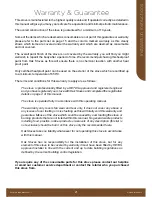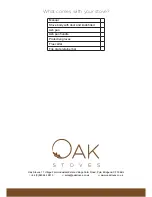
Zeta 10 Series Manual - V1.1
© Oak Stoves 2016
10
Cleaning & Maintenance
Our stoves are finished with high temperature resistant paint which can withstand the
temperatures expected in normal use. You may clean the stove with a damp lint-free cloth,
but ensure the stove is completely cold throughout before doing so.
To clean the glass on the door, again use a damp lint-free cloth to clean and ensuring that
you wipe with a dry cloth afterwards. Do not use any chemicals to clean the glass, this will
cause permanent damage to the glass. You may get deposits on the glass after the fire has
run, most of these will burn off if you run the fire again at a fast rate for a few minutes. Do not
use abrasive cloths on the glass or paintwork as these can cause scratching and permanent
damage to the stove.
Ash Clearance
With wood or peat fires you should allow some
build up of ash at the base of the firebox, however
it is necessary to remove some ash once the
build up gets too much. This will only be needed
when the build up starts to restrict the airflow by
blocking the front grill. Burning smokeless fuels
will require the ashpan to be emptied regularly, it
is very important to do this as this ash must not be
allowed to overflow over the grate.
This model has a Remote Riddle Plate Bar located
under the left side of the door, pulling this bar
will rotate the grills allowing excess ash to drop
through to the ashpan below the firebox
(see Fig.
4)
.
Be sure not to completely empty the base
of ash.
It is very important that all ash is cool before attempting to remove it from either the base or
the ashpan. We advise emptying the cold ash into a bin liner and sealing it before disposing.
Throat, Baffle Plate & Flueway Cleaning
It is very important that the throat, baffle plates and the flueway are kept clean and obstruction
free, failure to do so could result in dangerous emissions not escaping correctly. These fumes
can pose a serious health risk to occupants therefore it is necessary to clean both the throat
and baffle plates and the flueways at least weekly, or more frequently if needed.
To clean the throat and baffle plates, first remove the side bricks to enable you to easily
remove the throat plate. To access the flueway, remove the two saddle clips to release the
upper fibre board that covers the flueway. Any build up of soot should then be swept off the
plate down onto the fire. Refit parts in reverse order when cleaning is finished, for more detail
please refer to page 18.
Removing The Primary Air Knob
If you wish to remove the primary knob completely from the stove you just have to keep
turning the knob in an anti clockwise direction. The knob has 100mm of threaded bar fitted to
Fig. 4
Remote
Riddle
Plate Bar
Oper
a
ting Ins
tructions








































